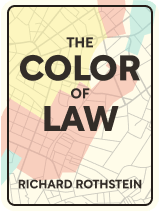

This article is an excerpt from the Shortform book guide to "The Color of Law" by Richard Rothstein. Shortform has the world's best summaries and analyses of books you should be reading.
Like this article? Sign up for a free trial here .
What is the difference between de facto and de jure segregation? Are all forms of segregation banned by the constitution?
The difference between de facto and de jure segregation is that de facto segregation is by personal choice or private practices, while de jure is due to discriminatory government policy. The Supreme Court ruled that de jure segregation is unconstitutional, while de facto segregation cannot be remedied by the constitution.
Read on to discover the history and examples of de facto and de jure segregation in housing.
The Distinction Between De Facto and De Jure Segregation in Housing
Widely reviewed and discussed when it was published in 2017, Richard Rothstein’s The Color of Law makes the case that racial residential segregation—the fact that African Americans largely live in discrete areas separate from white Americans—is the result of explicit government policy (“de jure” segregation) rather than personal preferences or random processes (“de facto” segregation). That is, historically, African Americans didn’t choose to live almost exclusively among themselves; rather, they were compelled to do so by an array of discriminatory policies designed and implemented by government at the federal, state, and local levels.
The distinction between de facto and de jure segregation is key. This is because segregation “by law” is unconstitutional and so remediable by legislation and litigation, whereas the Supreme Court has ruled that segregation “by personal choice” isn’t rectifiable under the Constitution.
Rothstein proves his claim that racial residential segregation was government-sponsored by examining the various means public officials used to promote segregation. Each chapter in the following summary focuses on one of these means, from the segregation of public housing to the exclusion of African Americans from federal home loans to the continual disadvantagement of African Americans in the labor market.
To emphasize the individual strategies government employed to segregate US localities, Shortform has had to omit some of the many examples Rothstein includes of racial residential segregation. (Those familiar with the book will also notice that we’ve redistributed the material that appears in the book’s first chapter and combined some shorter chapters.) As always, if you enjoy the summary and are curious to know more, we encourage you to consult the author’s work itself.
The History of De Jure Segregation
As noted in the introduction, de jure segregation is unconstitutional: It infringes the Fifth, Thirteenth, and Fourteenth Amendments to the US Constitution. It was also outlawed by the 1866 Civil Rights Act, which prohibited any law that echoed the characteristics of slavery by disadvantaging African Americans.
Unfortunately, in 1883, the Supreme Court determined that housing discrimination didn’t represent a continuation of the “badges and incidents of slavery.” It wasn’t until 1968—when the Supreme Court overturned the 1883 decision and, separately, Congress passed the Fair Housing Act—that racial discrimination in housing was unambiguously prohibited.
Between 1883 and 1968, African Americans were systematically and repeatedly disadvantaged in the housing market due to government policy—specifically through the Federal Housing Administration and the Veterans Administration—with repercussions that extend into today.
For example, the primary source of wealth for American families is their home. Because Black Americans were unable to obtain financing, from either the government or private banks, to purchase homes in the middle of the last century, their descendants haven’t inherited the same wealth that white Americans have.
These descendants are also unable to file suit for remuneration on account of this historical discrimination. Because the Supreme Court ruled housing discrimination legal between 1883 and 1968, descendants of those discriminated against have no legal standing to sue. S
The Denial of De Jure Segregation
Even after 1968, the Supreme Court continued to minimize the government’s role in creating housing segregation. For example, in 1974, in a case concerning the desegregation of urban and suburban Detroit’s public schools, Justice Potter Stewart, who wrote for the majority, claimed that the racial disparities between the city of Detroit and the suburbs were the product of diverse private acts rather than public policy. Ultimately, the Court ruled that the predominantly white suburbs couldn’t be included in a compulsory desegregation program.
(It’s worth noting that Potter’s decision overturned the ruling of a district court judge who found that federal, state, and local policy did indeed bear outsized responsibility for racial residential segregation.)
Potter’s position was echoed more recently by the Court. In 2007, in a case involving Seattle and Louisville public schools’ consideration of race in filling classes, Chief Justice John Roberts wrote that racial residential segregation (and thus public school segregation) was the product of private choice (“de facto”), and so the Court couldn’t allow a public remedy.
De jure and de facto segregation can indeed be hard to separate. “Structural racism,” which describes a societal condition in which both private attitudes and public institutions disadvantage people of color, illustrates this point.
Rothstein’s argument is not that de facto or private segregation doesn’t play a role in housing segregation. Rather, his point is that jurists like Stewart and Potter have overlooked the clear role of government policy in racial residential segregation, and so have unjustly excused governments from remedying it.
The Private Sector and De Facto Segregation in Housing
Not all efforts to maintain and further residential segregation originated with the federal government; three common strategies—restrictive covenants, blockbusting, and contract sales—developed among private enterprises. Nevertheless, the federal government consistently condoned—or, at the very least, ignored—these injustices.
Restrictive Covenants
Restrictive covenants are stipulations in deeds that obligate the owner of the property to undertake certain actions or follow rules. For example, a restrictive covenant might prevent the owner from painting the house a certain color. It might also—as it often did in the first half of the 20th century—forbid the owner from selling or renting to an African American.
However, if a white homeowner wanted to violate the covenant and sell a property to an African American, there was little his or her neighbors—who would be the ones “hurt” by the sale—could do about it. To get around this wrinkle in the law, developers began making it a requirement that people purchasing their properties join a community association—an association whose bylaws often included a whites-only clause.
The FHA, for its part, supported restrictive covenants by awarding low-risk ratings to properties that had them. Even after racial restrictive covenants were ruled unconstitutional by the US Supreme Court in 1948, the FHA continued to withhold loan guarantees unless deeds barred sale to African Americans. The justification? That the presence of African Americans reduced property values and so comprised greater risk. (In fact, the evidence shows that the presence of African Americans actually raised property values, because they often had to pay higher prices than whites for the same properties.)
It wasn’t until President John F. Kennedy issued an order forbidding the FHA to contribute to racial discrimination that FHA appraisers ceased this discriminatory practice. For racial restrictive covenants in general to be outlawed, however, African Americans would have to wait until 1972.
Blockbusting
Despite the fact that the presence of Black homeowners raised property values rather than lowered them, unscrupulous real estate agents were happy to take advantage of white fears of neighborhood decline. One way they did so was “blockbusting.”
First, real estate agents would gin up fear among whites in a given neighborhood that African Americans were starting to move in. Because whites believed the stereotype that an influx of Black residents meant declining home values and neighborhood distress, these white homeowners would sell their homes quickly and at a discount, thinking they were still coming out ahead.
Then, the real estate agents would turn around and sell the homes to African Americans at a premium. The African American families would move in, precipitating greater fear among their white neighbors and further discount sales. Before long, the neighborhood would be exclusively African American. (“Blockbusting” and “white flight” go hand in hand.)
Sometimes, agents wouldn’t even have to actually sell a home to an African American. For example, agents were known to pay African American women to walk through white neighborhoods with their babies in carriages, or African American men to drive through neighborhoods with the radio turned up, to frighten whites into selling cheap.
Contract Sales
When agents did sell to African Americans, they often employed a particular type of agreement called a “contract sale.” Under the terms of this agreement, the deed to the home would transfer to the buyer after fifteen or twenty years, but only if the buyer made every monthly payment over the term of the contract. If the buyer didn’t, they could be evicted immediately—because the payments didn’t earn the buyer equity in the home.
The repercussions of these burdensome payments—which were inflated by discriminatory real estate agents—were many and varied. It forced buyers to work multiple jobs or take in boarders to earn enough just to make their payments (many were evicted for nonpayment despite these efforts). The additional boarders created overcrowding in homes and local schools—so much so that many schools had to switch to morning shifts and evening shifts. The shifts gave rise to gangs, which gave rise to criminality, which caused whites to move out of integrated neighborhoods even quicker.

———End of Preview———
Like what you just read? Read the rest of the world's best book summary and analysis of Richard Rothstein's "The Color of Law" at Shortform .
Here's what you'll find in our full The Color of Law summary :
- How racial residential segregation is the result of explicit government policy
- The three reasons why racial segregation is so difficult to reverse
- The steps that could lead to a more integrated and equitable society






